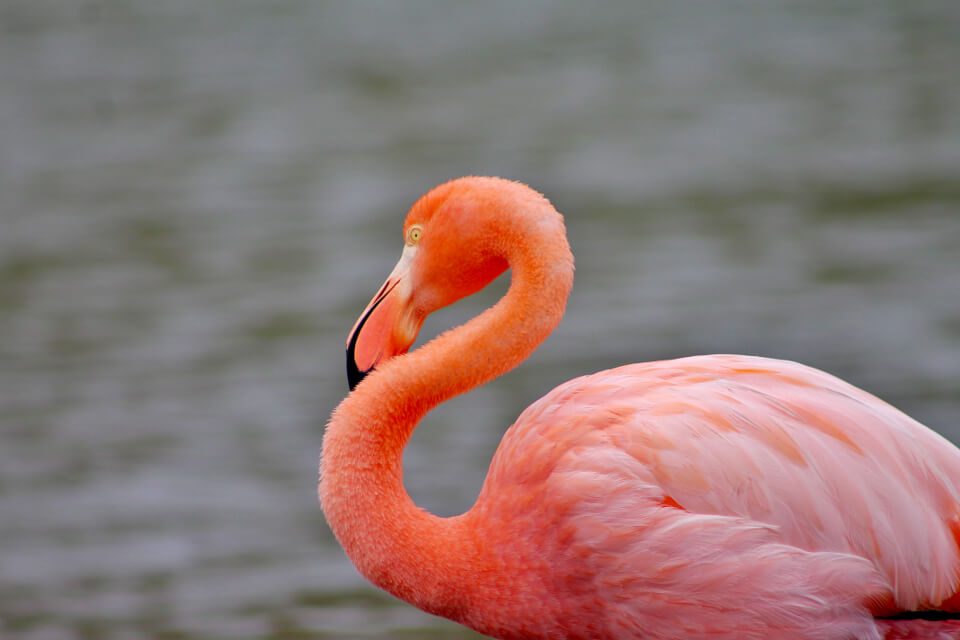The Galapagos islands are home to some of the world’s most vividly colored flamingos, among the most exquisite and fascinating birds. These magnificent birds give the islands their vivid pink hue, and it’s a common pastime to watch the curious actions of these aquatic Galapagos flamingos all around the islands.
TALK TO A DESTINATION EXPERT

Diego Zapata

Rosa Mena

Sandy Lara

Diego Zapata

Rosa Mena

Sandy Lara
CHARACTERISTICS
The flamingo is the bird species with the most extended neck and longest legs relative to its body size. Adults have a wingspan of 55 to 65 inches, measure 31 to 57 inches, and weigh roughly 6 pounds. Known by the moniker “rosy flamingo,” most of their feathers are a vivid pink, unlike the softer European or African varieties. The Galapagos flamingo’s wing coverts are red, while its primary and secondary flight feathers are black. The flamingos have all-pink legs and have a goose-like honking sound.
The Galapagos flamingo feeds on small crustaceans and tiny water plants. They use their characteristically crooked pink beaks with a black tip to remove silt and muck from their diet. The fact that flamingos can only feed with their heads upside down is fascinating. Lamellae, thin, flat membranes in their beaks, serve as food filters. Flamingos have been observed to stomp their feet in the water to get food from the bottom.
The brilliant pink coloring of Galapagos flamingos comes from their diet.

Crustaceans, which are their primary source of food, include pigments called carotenoids, which are what keep flamingos bright pink.
Galapagos flamingos often stand on one leg.
It is hypothesized that this resting posture lowers heart effort or preserves body heat. They can also be observed dozing off when seated, with their legs tucked under them. Flamingos seem to have a keen sense of hearing but not much or no sense of smell.
Although these flamingos are gregarious and live in colonies, observing these beautiful birds from a distance is preferable because they may be pretty shy around people. A sort of flamingo “daycare” called a crèche is where colonies of several hundred Galapagos flamingos live; they cooperate to protect and look after their young.
The Galapagos flamingo is believed to be monogamous and tends to stay with the same mate for a lifetime.
These flamingos engage in wooing as part of their collective mating rituals. Displays and parades are examples of group courtship rituals that include many people rather than just one couple. Colonies are used for nesting, and the breeding season lasts from July to March.
The appearance and color of Galapagos flamingos do not differ between the sexes. Throughout the 21–36 day incubation cycle, male and female flamingos build the nests, sit on the eggs, and nurse the young. Both sexes yield milk, and the young chicks are breastfed for around two months following birth.
Both the male and female Galapagos flamingos participate in building nests with the use of their beaks.
Feathers, straws, tiny stones, and mud are used to construct nests. To shield their young from the heat and floods, flamingos create a lofty mound for their nest that can reach a height of 12 inches. The female flamingo typically lays one egg at a time, and both parents sit on the nest. In colonies where many chicks are hatched simultaneously, nesting takes place. Until a natural event or human encroachment disturbs the ecosystem, the settlements are stable and typically return to the same nesting site each year.

Javier Garcia

Eduardo Silva

Carolina Escobar
START PLANNING YOUR TRIP

Javier Garcia

Eduardo Silva

Carolina Escobar
Get in touch for more
CONTACT US
Galapagos flamingos live in large colonies in the brackish, shallow waters of this archipelago off the coast of Ecuador.
Since flamingos are waders, they can be found in shallow waters. While flamingos can be seen throughout the islands, more significant colonies are in Santa Cruz, Rabida Island, Floreana Island, Santiago, and Isabela Island. Find out where these islands are by looking at our Galapagos Islands map.
Plan your trip to the Galapagos in the spring or summer to witness fascinating flamingo mating activity and young offspring. Although flamingo move is seen all year round, the flamingos typically breed from March to July.


